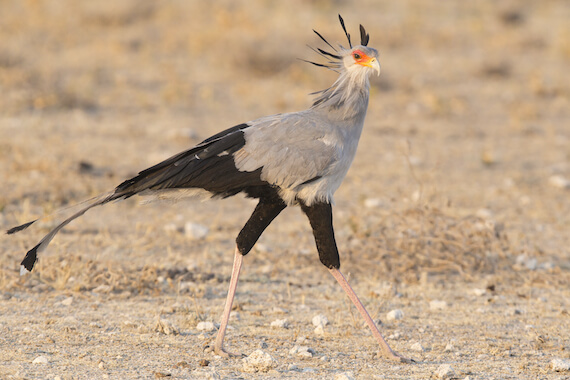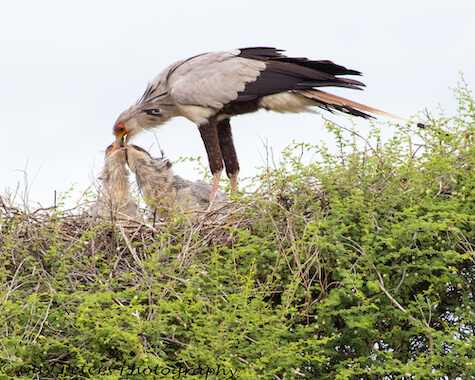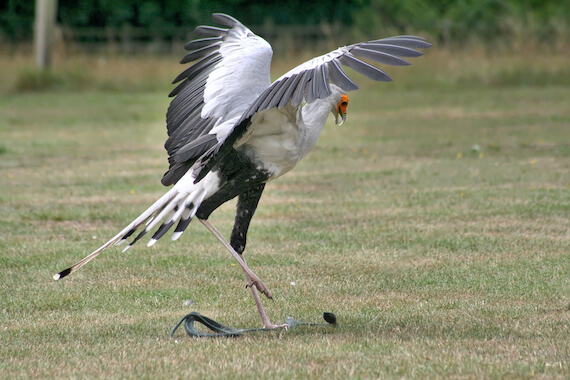
| Kingdom | Animalia |
| Phylum | Chordata |
| Class | Aves |
| Order | Accipitriformes |
| Family | Sagittariidae |
| Genus | Sagittarius |
| Species | Sagittarius serpentarius |
| Niche | Carnivorous terrestrial bird of prey |
| Height | 4.1 – 4.9 feet (1.2 – 1.5 meters) |
| Wingspan | 6.3 – 7.1 feet (1.9 – 2.2 meters) |
| Weight | 5 – 9.4 lb (2.3 – 4.3 kg) |
| Lifespan | 10 – 15 years |
| Social Structure | Monogamous pairing |
| Conservation Status | Vulnerable |
| Preferred Habitat | Grasslands & savannahs in sub-Saharan Africa |
| Average Clutch Size | 1 – 3 eggs |
| Main Food Item | Small mammals, reptiles, amphibians & birds |
| Predators | Eggs preyed on by other birds |
The Basics
The secretary bird is a species of terrestrial bird of prey native to the open grasslands and savannahs of sub-Saharan Africa. It is the only living species belonging to the family Sagittariidae. The heads and bodies of secretary birds resemble those of eagles, whilst their long legs resemble those of cranes and allow them to stand up to 4.9 feet (1.5 meters) tall. Secretary birds prefer areas with short grass less than 1.8 feet (0.5 meters) tall and avoid altogether areas with grass greater than 3.3 feet (1 meter) tall, as they need to see above the vegetation to hunt.
Secretary birds are one of only two terrestrial birds of prey, along with the caracaras of Central and South America. Being terrestrial means that these birds hunt on foot, which they are able to do thanks to their long legs that lift their body above the vegetation and allow them to spot prey easily. Secretary birds mainly hunt small mammals, reptiles, amphibians and birds, as well as large insects. They sometimes also scavenge for small animals that have already been killed by wildfires.
Secretary birds spend most of the day hunting for food and policing their territories, typically leaving the roost a few hours after dawn and only returning at dusk. Although these birds tend to hunt in proximity to their breeding partners or in small family groups, individuals generally remain spread out from each other. Secretary birds hunt throughout the day and only take a break to rest in the shade of a tree during the hottest part of the day. As a result, these birds can cover large distances of more than 20 miles (32 kilometers) per day.

Reproduction
Secretary birds are monogamous, meaning they mate with a single partner for life. Mated pairs are territorial and can defend territories up to 19 square miles (50 square kilometers) in size. Breeding can occur throughout the year but is most common in the late dry season. Both males and females take part in performing a nuptial display in which they soar high above the ground in an undulating pattern and make a load croaking sound. They might also perform a display on the ground whereby they chase each other with their wings up and back, which is also how they defend their territories.
Secretary bird pairs work together for up to six months to build their nest, which is usually placed at the top of a thorny acacia tree between 8 – 40 feet (2.5 – 13 meters) above ground. Secretary bird nests are composed of twigs, leaves, grasses, animal fur and dung, and can be up to 8 feet (2.4 meters) wide. Given the amount of work required to build a nest, pairs often use the same one for several years in a row.
Female secretary birds lay 1 – 3 pale blue-green or white eggs at 2 – 3 day intervals. Although both parents take it in turns to incubate the eggs, the female spends most of the time on the nest, especially at night. Eggs hatch after around 45 days in the order they were laid and both parents provide food for their chicks for at least 40 days after they hatch. Chicks typically leave the nest between 75 and 80 days after hatching. Unlike other birds of prey, secretary birds often successfully raise more than one chick, with all three chicks from a clutch of three tending to survive if enough food is available.

Fun Facts about Secretary Birds
The secretary bird may look a bit strange, but its unusually long legs actually make it extremely well-adapted for its terrestrial niche and provide examples of a number of interesting biological concepts.
Terrestrial Birds
Secretary birds spend most of their time moving around on foot rather than by flight. Although these birds can fly, flapping their wings is laborious and requires a lot of energy. As a result, when secretary birds do fly they tend to soar without flapping their wings or make use of thermal columns that can help lift them up to altitudes of 12,500 feet (3,800 meters). Due to these difficulties in flying and their ease in moving around on the ground, secretary birds only fly when necessary, for example to reach their nests in trees or to perform courtship displays.
Secretary birds aren’t the only species to have developed a terrestrial lifestyle, however. In fact, certain birds including penguins, kiwis and ostriches have evolved to forego flying altogether. Given that terrestrial bird species belong to various unrelated taxonomic groups, it is clear that losing the ability to fly well (or at all) has occurred on numerous separate occasions throughout history, likely to give way for adaptations that allowed these birds to thrive on land.
Unique Hunting Technique
Secretary birds use a number of innovative hunting techniques to capture and kill their prey. For example, when searching for prey, they stomp on vegetation to flush out animals from areas of tall grass. They then chase down their prey and strike it with either their bill or their feet until the animal is dead or at least stunned enough to eat. It has been found that these birds are able to strike their prey with their feet using a force up to 5 times their own body weight, with a contact period of only 10–15 milliseconds, making them extremely well-adapted for this hunting style.
Secretary bird feet have very short toes and limited grasping ability. Therefore, rather than carrying prey away with their feet like other birds of prey, they tend to eat it immediately or carry it away in their beaks. Secretary birds normally eat their prey whole, although sometimes they will hold it down with their feet whilst tearing it apart, similar to other birds of prey.
The Archer of Snakes

The taxonomic name for secretary birds, Sagittarius serpentarius, translates as ‘the archer of snakes’ and reflects this bird’s ability to kill even dangerous venomous species of snake using its characteristic stomping technique. Whilst the secretary bird’s strong kick allows it to stun or even kill venomous snakes including adders and cobras, it also has a number of other features that prevent it from being fatally bitten by its prey. For example, the tough scales on the lower legs of these birds protect them from potential bites to their legs. In addition, their long flapping wings serve as a distraction from other, more vulnerable body parts, as a snake bite to a hollow feather would cause no harm to these birds.
